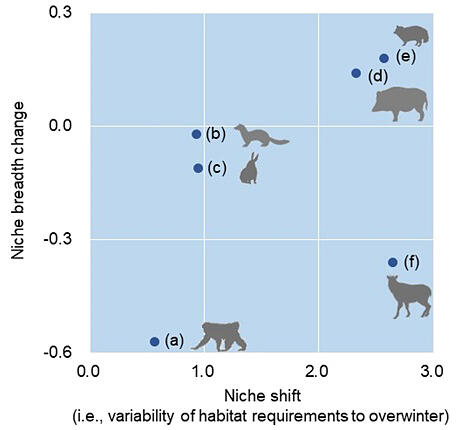Professor Hiroto Enari and his colleagues at the Faculty of Agriculture at Yamagata University, announced that the results of their survey of the Towada, Asahi, and Iide mountain systems in the Tohoku region and ecological niche analysis to evaluate the effects of extreme snowfall on the behavior of various mammalian species revealed that "body size" and "dietary habits (staple food in winter)" may be factors determining tolerance to extreme heavy snowfall. There are concerns that climate change may pose a new threat to biodiversity. The results were published in the February issue of Frontiers in Zoology, an international journal published by the German Zoological Society.

(1) Niche breadth change: The species with higher values could expand niche breadth (i.e., the diversity of habitat environments tolerated by an individual) when the amount of snowfall increases.
(2) Niche shift: The species with higher values could overwinter by using habitats which are more different from usual when facing with extreme snowfall.
*Analysis for red foxes could not be conducted because of insufficient sample size.
Provided by Yamagata University
Although recent climate changes have resulted in warming leading to higher average temperatures, extreme climate events, including severe cold waves that cause unusually heavy snowfall, have also increased in frequency and magnitude. The research group used ecological niche analysis (a method to estimate the behavioral patterns of wild animals in forests) to evaluate the effects of heavy snowfall on the behavior of seven different native mammals (wild boar, Japanese macaque, red fox, Japanese marten, Japanese hare, raccoon dog, and Japanese serow) over a total distance of 1,144 km in the Towada, Asahi, and Iide mountain systems in the Tohoku region from 2015 to 2020, including heavy snow years. The team surveyed the habitat use by the target species in the above regions by mountain skiing with students and recording the footprints of the target species on the snow.
The analysis showed that wild boars, who are most disadvantaged in moving on the snow-covered surface due to their body shape, tended to congregate in sunny, low attitude areas and flee to cedar plantations for overwintering when extremely heavy snowfall occurred. They also found that small-bodied mammals (Japanese marten, Japanese hare, and Japanese macaque) are unable to significantly change their habitat use in the face of extremely heavy snowfall.
Moreover, the habitat use of herbivorous species (Japanese serow, Japanese hare, and Japanese macaque that eat bark and winter buds) were found to be strongly restricted during extremely heavy snowfall because their staple foods during winter are largely buried under snow. These findings indicate that "body size" and "dietary habits" may be factors determining the tolerability of different mammalian species to extremely heavy snowfall.
Enari said, "Medium-to-large-sized mammals tend to be considered as pests that cause damage to food crops, and many argue that, while extinction should be avoided, their populations should be reduced to the smallest possible sizes. However, these common species also constitute one of the backbones supporting the functions of the forest ecosystems. The increased frequency and magnitude of extreme climate events due to recent climate changes have proven to be a risk to such a backbone, and we cannot overlook that risk. As we continue to explore the effects of various extreme climate events on mammals, we hope to identify new possible risks to the ecosystems."
Journal Information
Publication: Frontiers in Zoology
Title: Differences in spatial niche of terrestrial mammals when facing extreme snowfall: the case in east Asian forests
DOI: 10.1186/s12983-024-00522-6
This article has been translated by JST with permission from The Science News Ltd. (https://sci-news.co.jp/). Unauthorized reproduction of the article and photographs is prohibited.




